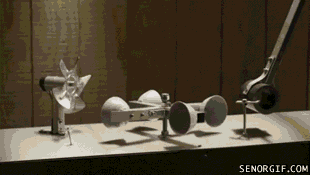Creative Email Marketing
FOR BRANDS WITH A MESSAGE WORTH SPREADING

(This is Part 2 of our 6 Part Marketing Automation Mastery Series. If you want to see all the topics we cover in this series, click here.)
Have you ever been at the gym and see someone using a piece of equipment totally wrong?
I mean, like, “that person is going to hurt themselves but I can’t look away” kind of wrong.
Well, I hate to say it, but when you jump into building automations with knowing what you’re doing, most end up looking like…

Once you get a taste for marketing tech, it can be tempting to wander outside of your area of expertise. In fact, most of the promotional videos you’ll watch make it seem like these tools are so easy to use that you’ll have them up and running in a flash…
Trust me, that almost never happens.
More often, you end up wasting time trying to learn yet another tool without even having a very clear idea of why exactly you need it or how precisely it fits into your existing technology stack for your business.
The Wrong Way to Automate
Never one to pass up a good pun, alliteration, or metaphor, allow me to compare poor automation to fitness.
Every mistake in automation can be compared to mistakes in the gym.
Mistake #1: Not Warming Up
You’ve had it happen. You’re in a hurry, you rush to go for a run or get to the gym, and you skip the warm-up.
Without so much as a trusty set of middle school PE arm circles, you rush into your workout.
Things go okay for a minute, then…
“Ooof! What was that? Oh no, that’s not supposed to bend that way…”
You pulled, popped, tore, twisted, strained, or sprained something, and you can bet it ain’t gonna be better in the morning.
In automation, you need a warm-up too.
Running headfirst into high-level automation without any experience is like climbing off the couch and stumbling straight into a strongman competition.
Sure, you might be able to get your hands around the refrigerator, but good luck picking that sucker up and hurling it over the fence… or whatever strongmen do.

(actual footage of the Appliance Delivery Man of the Decade)
Most automation has levels. Meaning, you can start simple and then scale up.
You don’t need crazy funnels and flashy nonsense to get great results.
Start small, warm-up, and at least put in the due diligence for a technology toe-touch before getting started.
Mistake #2: Not Having a Goal
Walk into a gym without a goal and you’re likely to find yourself wandering around the weights hoping to find muscles or stumble into the special strength sauce.
Hint: They’re not hiding beneath the plates, they’re in the program.
You have to know what you’re trying to accomplish before you start.
Are you trying to tackle a marathon? Well you’re probably going to need to build some endurance.
Looking to pump up your pecs? Might need to beef up your bench.
Much like when you need to get dents out of your car, the gym is basically a body shop, too. It’s filled with tools, but they each have a specific purpose.
Automation needs a goal – a problem to solve.
If you’re trying to cut out redundant manual work, then you can look for a tool that helps do that exact task.
If you love sending handwritten cards to your clients but it’s taking too much time, now you’ve got a use case to search for a solution.
Start with the end in mind, then the tool go find.
Yoda rhyme, that was.
Mistake #3: Poor Selection
Great, so you’ve warmed up and you know what you’re working toward. Solid start.
You know you’re trying to improve your leg strength, you read that you need to lift weights, you hear squats are great, so you bustle over to the bar and load up your back.
Time to squat.
You’re not very familiar with the form, but you figure you’ve seen it enough times so you give it a go.
There’s a mirror in front of you, but you quite quickly decide that nobody’s eyes should be subjected to watching this squat-trocity, not even your own.
You fumble through the set feeling a little less than confident in your form, and a lot less confident in your ability to impress the onlooking bodybuilders.
Choosing the wrong exercise is akin to choosing an automation tool that’s a bad fit but “that looks like what I’ve seen.”
For building leg strength, a squat is great… but it’s also very difficult to master. You could start with other machines and exercises that achieve the same goal without the risk of poor form.
In automation, this could be compared to choosing a complex marketing automation tool that you’ve seen other brands using, but that’s far too technical for your needs.
*cough* Infusionsoft *cough*
While it shouldn’t eat up all of your focus, it is very important to spend time choosing the right tool that fits your current needs, skills, and resources.
Mistake #4: Getting Injured
Prematurely jumping into the deep end doesn’t always end up with you getting hurt. Sometimes it just ends up with a touch of embarrassment realizing it’s obvious you don’t know what you’re doing.
But if you push too hard, too fast, or too far, you’re likely to get injured.
It will happen no matter how good your intentions are.
This is absolutely, inarguably, and just as destructively true when it comes to automation.
Whereas you may blow out a knee in the gym, you could blow up your list with the wrong setup in your marketing technology…
And sometimes all it takes is one wrong click.
Accidentally hit the wrong list with a promotion or email blast and you may piss off a chunk of your list and damage your reputation with them.
Just like getting sloppy with the weights can damage the integrity of your joints, messing up your marketing can damage the integrity of your brand.
Mistake #5: Not Hiring a Trainer
There’s no shame in asking for help. Even the best athletes in the world have coaches.
Whether you’re just getting started in the gym or if you’re an Olympic hopeful, you can be dang sure that getting some guidance will get you there quicker.
A trainer can see what you’re doing from a different perspective, listen to your goals, and provide expert strategy, tactics, and mentorship to get you to your goals as fast, effective, and safely as possible.
Marketing technology takes skill, experience, knowledge, and a surprising amount of confidence to execute properly.
If you aren’t excited by the thought of learning yet another technology skill set to run your business, then maybe you shouldn’t. There are plenty of people like us who actually love the technological side of setting up automation.
Not only will this prevent you from painful mistakes, it lets you stay focused on the things that you’re uniquely qualified and capable of doing in your business.
Now that I’ve thoroughly exhausted the gym metaphor, how about we take this into the kitchen for a post-workout protein shake?
Using Automation the Right Way
Have you ever bought a new kitchen appliance and immediately realized you just leveled up your culinary capacities to Michelin Star status?
This happened to me twice…
Believe it or not, you’re about to learn an awful lot about automation from the wisdom of two clever culinary contraptions.
I’ll show you why effective marketing looks a lot less like walking into a Gordon Ramsay restaurant and a lot more like having a good can opener.
From Appliance to Automation
With your automation, you need Blendtecs and air fryers.
Blendtec Lessons
My first a-ha was when I got a Blendtec blender. You know, the commercial kind they use at places like Jamba juice? Let’s just say my smoothie game has never been the same since.
…and neither has my noise-approval rating from my neighbors. Oops.
Truth be told, my blender doesn’t allow me to serve up a stunning souffle or even pump out the perfect Hot Pocket. But it allows me to do ONE thing better than 99% of people: make a killer smoothie.

Here’s the beauty of having a badass blender…
Once I knew I could reliably whip up spectacular smoothies, I wanted to make them more often. When friends come over, I confidently tout that Jamba Juice can’t hold a candle to Joe-ba Juice and I fling open the fridge to prove it.
When it comes to automation, the exact same thing applies.
You don’t need all the bells and whistles for every task in your business. More often, it’s far more powerful to have an amazing tool that you learn how to use really well, produce reliable results, and then get better and faster with it.
For example, email marketing can be as simple or complex as you want it to be. You can go no further than a weekly newsletter, or you can turn it into a set of interworking automations and integrations that look more like a Rube Goldberg machine than a marketing system.

Even though I love love love figuring out complicated and intricate automation puzzles, you should never start there.
Instead, it makes more sense to just nail it on the basics. Build the Blendtec version of a newsletter or welcome automation.
Every business should focus on doing only one or two things at the highest level. That is your area of expertise. That is the market that you’re able to serve better than anyone else can. That’s where you need the occasional Blendtec.
Nobody is impressed when you’re “okay” at a lot of things compared to being brilliant at one thing.
Find the one area that is the most critically important to your core offer, go get the best-in-breed tool for that task, then master it.
“But I have so many different things I need to do in my business. I can’t get away with just one tool! It takes 3 apps and a customer support agent for me to make a bowl of Fruit Loops!”
Indeed you’re right. Even the bedazzling power of a Blendtec will eventually reach its limits.
Enter the air fryer…
Air Fryer Lessons
To tell you the truth, I held off on getting an air fryer for years. I always knew I wanted one, but figured I could do most of the same things with an oven, so I drug my feet.
After a while, I had seen enough amazing recipes and meal ideas that I finally took the plunge and bought one.
Oh… my… god…
Game changer.
Unlike the Blendtec, the air fryer isn’t uniquely built to produce one amazing result. Where the air fryer shines is how quick and easy it’s able to create many great results. Best of all, I can dish up these delicacies reliably.
If my Blendtec is the specialist, my air fryer is the jack-of-all-trades.
There will always be other things outside of your core offer or service that you still need to do. Even a smoothie shop still needs to mop the floors and change the lightbulbs.
But the wrong decision is to start filling in the gaps with different tools for every single task you need done.
“Go hire a lightbulb engineer, master mopper, and bespoke banana peeler, stat!”
Air fryer automation is about finding one flexible tool that can do the majority of tasks you need done. Now here’s the key…
It doesn’t need to do all of those things the best. It just needs to do them well.
No matter what kind of business you have, you’re sure to have a million things that you need to do, and god save you if you get a tool for every one of them. That’s a surefire way to fill your browser with a tsunami of open tabs and load your phone with an avalanche of apps that will be more than happy to ring and ding for your attention at all hours of the day and night.
You want to consolidate all of those tasks into a “good enough” system that keeps it clean, simple, organized, and gets you back to focusing on your Blendtec tasks.
One for the Best, One for the Rest
Not only did these tools change the way I cook every single day, it made me realize how much more I could do with only two simple appliances.
Automation should really be the same.
It isn’t about having all the bells and whistles. It’s about giving yourself some flexible options that you learn how to use really well.
As with almost everything, the 80/20 rule should be in mind at all times when choosing new automation tools. Most of your results come from a small set of actions.
When you find the 20% of tasks that deliver 80% of the results, bust out your Blendtec to serve up that super special smoothie.
But the other 80% that still needs to be done, even if it only drives in 20% of the results… That’s when you call on the ol’ trusty air fryer to pick up the pieces.
Example: Airfryer Automation and Blendtec Business
Let’s put some meat on this metaphor. What does this actually look like?
In our agency, ActiveCampaign is our Blendtec.
We committed to going deep on mastering the platform (even becoming Certified Consultants) so we could provide the best possible results for our clients.
We learned the ins and outs, spent years working with dozens and dozens of clients building thousands of automations and sending millions of emails.
Now we know we can bust out our Blendtec-level badass automations with ActiveCampaign for nearly any client who needs help leveling up their marketing.
When it comes to our air fryer, we lean on a small set of dynamic tools that let us do the vast majority of the rest of our work. For example, Typeform, OptinMonster, and Zapier.
When it comes to your tools, our philosophy isn’t literally to only have two tools – it’s simply to have one or two that you master, and a couple that you lean on for the rest you need to do.
A simple way to think about it is: as many as necessary, but as few as possible.
For other businesses, ActiveCampaign is their air fryer. It lets them do such a wide range of tasks from email marketing, sales automation, CRM, and pipeline management… it fits a variety of their needs so they can focus their expertise on whatever their core offer is.
Once you’ve narrowed down your tools and pumped up your powerhouse of automation capabilities, you need to dive into your 80/20 and figure out how to scale up what’s working.
Take Action
Do an audit of your tasks and technology. There’s no “golden ratio” here, but I can promise you that the closer you are to 1:1 for your task to tool ratio, the most scattered your life is going to feel.
Way too often we automate things that don’t really need to be done at all. Sometimes cutting things out entirely is better than handing them off to automation. As Tim Ferriss says, don’t automate things you can eliminate.
In one column, write down all the tools you use in your business. If you aren’t even sure what you use, check your credit card statement. You’re probably paying for a good handful of them.
In the next column, write down the task it serves. I suggest that you create a new row for every task, even if the tool is the same. Because…
In the third column, write down if this is necessary to automate, or if it could be eliminated. If you can cut it with little to no consequence, then scrap that sucker. But if you need to keep it…
In the fourth column, see if any of your other tools can take over that task. Maybe they can’t do it quite as well, but can they do it well enough? If so, consolidate that task into your other system and say bye-bye to a bloated tech stack.
If you find that multiple tools could do the job or you aren’t sure which should stay or which should go, here are a few ideas for assessing your tech. You could even use this list to evaluate new tools:
- Which have the most flexible integrations? Do they integrate into Zapier or other platforms?
- Which has the most favorable price point?
- Which has the least growth restrictions? Do some limit the number of users/visits/tasks within your current plan?
- Which do you enjoy using the most? Which feels easier or more fun when you login to the dashboard?
- Which do other people on your team know how to use? Does someone else know how to step in for any of the tools you already use?
- Which is the cheapest to outsource? Can you find more affordable freelancer help for some tools compared to others?
- Which has the best reviews? Can you check sites like g2crowd to get a better idea on which is more stable or flexible?
- Which has been updated the most regularly? Which tools are adapting and evolving to keep up with other tools and marketing strategies?
- Which are the most proven? Are any of the tools more widely used, respected, or established in terms of results and reliability?
- Which have the best support and customer service?
Conclusion
The right and wrong use of automation ultimately comes down to knowing where you’re at (skills, knowledge, and resources) and what you’re trying to accomplish.
With the right framework and approach, you can simplify the process by keeping your focus on as few tools as possible to accomplish amazing experiences for your subscribers and customers.
Start slow, see what works, and be intentional with every choice you make that impacts the customer on the other end. Often, the “right” approach is the simplest, especially when you’re starting out.
In the next in our series of Marketing Automation Mastery, you’ll learn how to use automation to scale up the best possible experience for each subscriber and customer that engage with your brand.
ABOUT US
We help mission-driven coaches and personal brands grow their businesses by mastering their marketing.
Need more help?
We’re always here to help you audit your email marketing technology and systems. Whether you’re starting from scratch or streamlining your marketing masterpiece, we can find new ways of improving your setup.
> Click here to learn how we can help.
Marketing Automation Mastery: Where It Works and Where It Hurts.
[PART 1]
Still hazy-eyed and sluggish, you take the first sip of coffee to start your day.
Ahhh… sweet, sweet outsourced energy.
You boot up the computer, which miraculously lights up without any caffeine coursing through its circuits… unimaginable.
You open your email and are immediately bombarded with dozens of brands trying to steal a minute of your attention. They’re selling something, and you probably aren’t buying.
Marketing Automation Mastery: Scaling the Best Experience You Can.
[PART 3]
Much like the way cranberries somehow found their way into every known juice on the planet, automation technology is digging its digital hooks into almost everything we do.
In the right hands, this tech can be one of the most powerful ways to ensure that every single subscriber gets a consistently positive (and personalized) experience with your brand.
Marketing Automation Mastery: Double Down on Different
[PART 4]
I skipped my weekly Automation Addicts Anonymous meeting to take another stab at convincing you that there’s more you could be doing with the wonderful wizardry of the tools available to you for building a scalable and sustainable business.
Come on… join us.
You should be using every technological tool at your disposal to create amazing experiences for your readers, and you better have a good system to do it.




